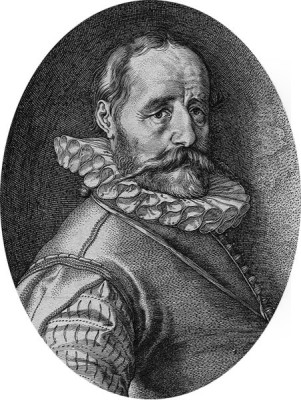
Hans Bol (1534–1593) stands as a significant figure in the rich tapestry of Flemish and Dutch Renaissance art. Born in Mechelen, then part of the Habsburg Netherlands and now in Belgium, Bol was a versatile artist renowned for his exquisite miniatures, detailed landscape paintings, and prolific work as a draughtsman and print designer. His career spanned a tumultuous period in the Low Countries, marked by religious strife and political upheaval, which profoundly impacted his life and artistic trajectory. Despite these challenges, Bol cultivated an international reputation, influencing a generation of artists and leaving behind a legacy of works celebrated for their meticulous detail, vibrant naturalism, and innovative compositions.
Early Life and Artistic Formation in Mechelen
Hans Bol was born in Mechelen in 1534 into a family with artistic inclinations, although his father, Simon Bol, was not a painter himself. The city of Mechelen was, at the time, a notable artistic center, providing a fertile environment for a budding artist. Bol's formal artistic training began at the tender age of fourteen, a common practice for apprenticeships during that era. He was fortunate to learn from two of his uncles, Jacob Bol I and Jan Bol (or Johannes Bol), both of whom were painters. This familial connection likely provided him with a solid foundation in the techniques of painting, particularly in watercolor and tempera, which were his early specializations.
His talent developed rapidly, and by 1560, Hans Bol was admitted as a master into the Mechelen Guild of Saint Luke. This membership was a crucial step for any professional artist, granting them the right to take on pupils and sell their work independently. During his early years in Mechelen, Bol primarily produced large-scale works in watercolor and tempera on canvas. These pieces, often depicting landscapes and biblical or mythological scenes, gained considerable popularity.
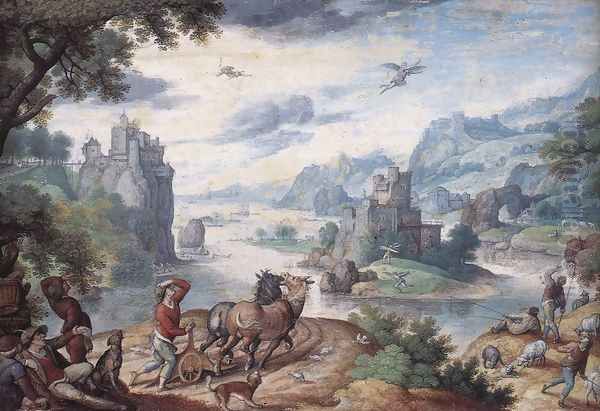
However, this popularity came with a downside. His distinctive style and successful compositions became targets for copyists and forgers, who replicated his works, diminishing the value and exclusivity of his originals. This widespread imitation prompted a significant shift in Bol's artistic practice. To counteract the problem of unauthorized reproductions and to cater to a growing market for more refined and personal artworks, Bol began to focus on creating highly detailed miniature paintings on parchment and vellum. This strategic move not only protected his artistic integrity but also proved to be financially astute, as these intricate and portable works were highly sought after by collectors and connoisseurs across Europe.
The Transition to Antwerp and Artistic Maturity
The relative stability of Bol's early career in Mechelen was shattered by the political and religious conflicts that engulfed the Netherlands in the latter half of the 16th century. The iconoclastic fury (Beeldenstorm) of 1566 and the subsequent harsh repression under the Duke of Alba created an atmosphere of fear and instability. In 1572, Mechelen was brutally sacked by Spanish troops during the Eighty Years' War, an event known as the "Spanish Fury in Mechelen." This catastrophe forced Hans Bol, like many other artists and citizens, to flee his hometown.
He sought refuge in Antwerp, which was then the preeminent commercial and artistic hub of Northern Europe. Arriving in Antwerp around 1572, Bol joined the city's Guild of Saint Luke in 1574. Antwerp offered a vibrant artistic community and a sophisticated clientele. Here, Bol continued to develop his specialization in miniature landscapes, often executed in gouache on parchment. His reputation as a master of this delicate art form grew substantially during his Antwerp period. He also produced numerous drawings that served as designs for engravings, collaborating with prominent print publishers such as Hieronymus Cock and Philips Galle, whose workshops disseminated his imagery to a wider audience.
During his time in Antwerp, Bol's style matured, integrating the meticulous detail characteristic of the Flemish tradition with an increasing understanding of atmospheric perspective and panoramic compositions, likely influenced by the pioneering landscape work of artists like Joachim Patinir and Herri met de Bles, and more directly by his eminent contemporary, Pieter Bruegel the Elder. Bol's landscapes from this period often feature expansive vistas, populated with small figures engaged in daily activities, biblical narratives, or mythological scenes, all rendered with remarkable precision.
Artistic Style: Landscapes, Miniatures, and Prints
Hans Bol's artistic output was characterized by its diversity in medium and subject matter, yet unified by a consistent attention to detail and a profound appreciation for the natural world. His style evolved throughout his career, but certain core elements remained.
Landscape Painting:
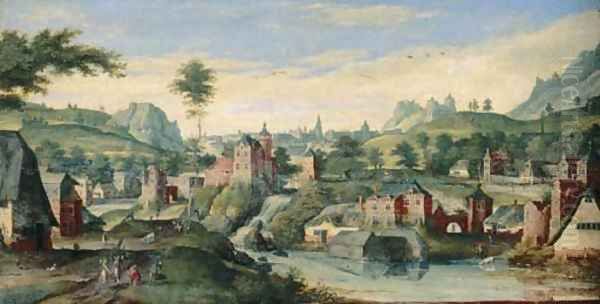
Bol was a key figure in the development of landscape painting as an independent genre in Northern European art. While earlier artists like Joachim Patinir had pioneered the "world landscape" (Weltlandschaft), Bol, alongside contemporaries such as Pieter Bruegel the Elder and Lucas van Valckenborch, further refined and popularized this genre. His landscapes are often characterized by a high viewpoint, allowing for panoramic vistas that recede into hazy, atmospheric distances. He masterfully employed color to create a sense of depth, with warm browns and greens in the foreground, cooler greens and blues in the middle ground, and pale blues and lavenders in the far distance, a technique known as atmospheric perspective.
His landscapes were rarely empty; they were stages for human activity. These could be scenes from the Bible, such as Abraham and the Angels, or mythological tales like Landscape with the Fall of Icarus. He also depicted contemporary peasant life, seasonal activities, and bustling village scenes, echoing the thematic concerns of Bruegel. Works like Winter Landscape with Skaters showcase his ability to capture the specific mood and activities of a season with lively detail.
Miniature Painting:
It was in the realm of miniature painting that Hans Bol achieved perhaps his greatest contemporary fame and financial success. Working primarily in gouache on parchment or vellum, he created jewel-like compositions of extraordinary delicacy and precision. These miniatures, often no larger than a postcard, could contain a wealth of detail, from the intricate rendering of foliage and architecture to the expressive depiction of tiny figures.
His subjects for miniatures were diverse, including series depicting the Four Seasons, Months of the Year, biblical stories, and mythological scenes. Summer and Winter, a pair of miniatures, exemplifies his skill in contrasting seasonal atmospheres and activities within a small format. Landscape with the Story of Venus and Adonis is another fine example, combining a central mythological scene with an ornate, thematically related border, a common feature in illuminated manuscripts that Bol adapted for his cabinet miniatures. These works were highly prized by collectors for their exquisite craftsmanship and portability.
Drawings and Print Designs:
Hans Bol was a prolific draughtsman. Many of his drawings were preparatory studies for his paintings or miniatures, while others were specifically created as designs for engravings and etchings. His drawings exhibit a fluid and confident line, often executed in pen and ink with washes to indicate shading and volume.
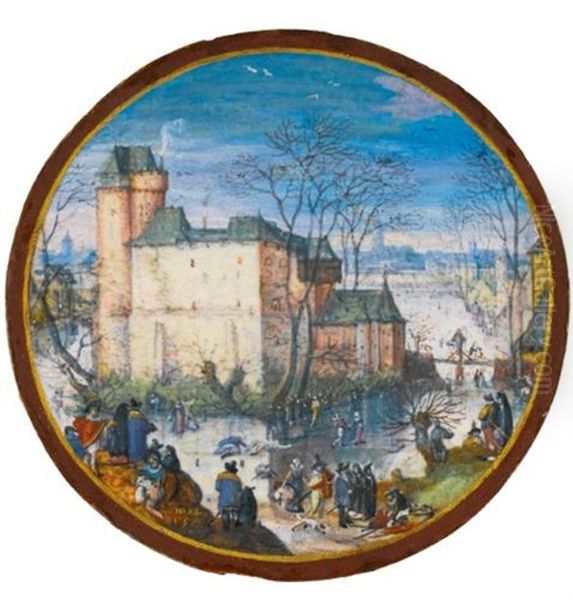
He collaborated extensively with printmakers and publishers, most notably the workshop of Hieronymus Cock and later Philips Galle in Antwerp, and also with his student Hendrick Goltzius, who became one of the most celebrated printmakers of the era. Bol's designs were translated into prints that circulated widely, further enhancing his reputation and disseminating his compositional innovations. Series of prints after Bol's designs, such as landscapes, hunting scenes, and allegorical subjects like An Allegory of Autumn, were popular throughout Europe. His etching Rebecca and Eleazar at the Well demonstrates his own skill in the print medium, characterized by fine lines and delicate tonal variations.
Key Themes and Subjects in Bol's Oeuvre
Hans Bol's thematic repertoire was broad, reflecting the diverse tastes of his patrons and the artistic conventions of his time.
Biblical Narratives: Religious subjects remained a staple for artists in the 16th century, and Bol produced numerous works depicting scenes from both the Old and New Testaments. These were often set within expansive landscapes, where the narrative element, though important, was sometimes subordinated to the depiction of nature. Examples include Abraham and the Angels, The Preaching of Saint John the Baptist, and Balaam and the Ass. These scenes allowed Bol to combine his skill in figure painting with his mastery of landscape.
Mythological and Allegorical Scenes: Classical mythology, particularly Ovid's Metamorphoses, provided a rich source of inspiration for Renaissance artists, and Bol was no exception. Landscape with the Fall of Icarus is perhaps his most famous mythological work, showcasing his ability to integrate a dramatic narrative into a sweeping, atmospheric landscape. He also painted other mythological subjects, such as Landscape with the Story of Venus and Adonis. Allegorical themes, such as the Four Seasons or personifications of virtues and vices, were also common in his work, often presented in series of paintings or prints.
Genre Scenes and Depictions of Daily Life: Following the tradition established by artists like Pieter Bruegel the Elder, Bol frequently depicted scenes of peasant life, village festivals, markets, and seasonal labors. These works provide a vibrant glimpse into the everyday world of the 16th-century Low Countries. His Winter Landscape with Skaters is a classic example, capturing the joys and activities of a winter day with charm and vivacity.
Pure Landscapes: While many of his landscapes served as settings for narrative or genre scenes, Bol also contributed to the development of pure landscape painting, where the depiction of nature itself was the primary subject. These works emphasized atmospheric effects, the changing light of different times of day, and the varied textures of the natural world.
Major Works: A Closer Look
Several works stand out in Hans Bol's extensive oeuvre, exemplifying his skill and artistic vision.
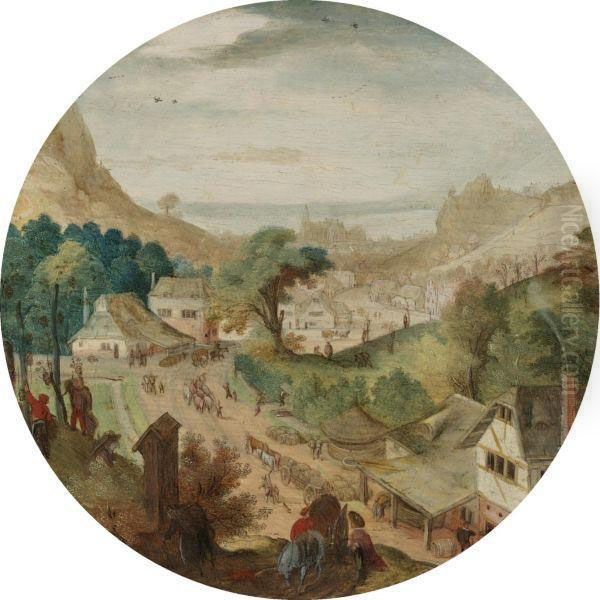
Landscape with the Fall of Icarus: This watercolor and gouache on parchment, housed in the Mayer van den Bergh Museum in Antwerp, is arguably Bol's most celebrated work. It depicts the tragic myth of Icarus, who, flying too close to the sun with wings made of feathers and wax, plummets into the sea. Bol follows the compositional tradition established by Pieter Bruegel the Elder in his own version of the subject, where Icarus's fall is a small detail in a vast panoramic landscape. The focus is on the indifferent beauty of the natural world and the ongoing activities of ordinary people, highlighting the insignificance of individual tragedy within the grand scheme of things. Bol's meticulous rendering of the coastline, the ships, and the distant mountains, all bathed in a soft, atmospheric light, is masterful.
Abraham and the Angels: This work, with versions found in collections like the Harvard Art Museums, showcases Bol's ability to render biblical scenes with both narrative clarity and landscape interest. The figures of Abraham and the celestial visitors are typically placed within a detailed natural setting, emphasizing the divine encounter occurring within the earthly realm. The careful depiction of trees, foliage, and distant vistas is characteristic of Bol's style.
Summer and Winter: This pair of miniature paintings, often executed as part of a larger series of the Four Seasons, demonstrates Bol's exceptional skill in the miniature format. Each scene would be filled with tiny figures engaged in activities appropriate to the season – harvesting and revelry in summer, ice skating and indoor warmth in winter. The precision of detail in these small-scale works is remarkable, capturing the essence of each season with vibrant color and lively characterization.
Rebecca and Eleazar at the Well: As an etcher, Bol also made significant contributions. This particular etching displays his fine, controlled lines and his ability to create a sense of depth and texture through the print medium. The biblical story is presented with a focus on the interaction between the figures, set against a carefully delineated landscape background. Such prints made his compositions accessible to a wider audience.
An Allegory of Autumn: This drawing, likely a preparatory sketch for an engraving and now in the Harvard Art Museums, is typical of Bol's allegorical works. It would feature personifications and symbols associated with autumn, such as harvesting, wine-making, and abundant fruits, often set within a landscape transitioning into the cooler months. These allegories were popular for their intellectual content and decorative qualities.
Influences, Contemporaries, and Students
Hans Bol's art was shaped by a variety of influences and, in turn, he influenced his contemporaries and students.
Influences:

The most significant influence on Bol's landscape painting was undoubtedly Pieter Bruegel the Elder (c. 1525–1569). Bol admired Bruegel's panoramic compositions, his depictions of peasant life, and his ability to capture atmospheric effects. After Bruegel's death, Bol was even commissioned to complete or create works in Bruegel's style, such as designs for a Four Seasons series of prints. Earlier landscape pioneers like Joachim Patinir (c. 1480–1524) and Herri met de Bles (c. 1510–c. 1555) had laid the groundwork for the independent landscape genre, and their influence can be seen in Bol's expansive vistas. The general tradition of meticulous detail and naturalism inherent in Early Netherlandish painting, exemplified by masters like Jan van Eyck (c. 1390–1441), also formed the bedrock of Bol's technique.
Contemporaries:
Bol worked alongside many talented artists. In Antwerp, he would have been aware of the work of landscape specialists like Lucas van Valckenborch (c. 1535–1597) and his brother Marten van Valckenborch (1535–1612), who also fled the southern Netherlands and worked in a similar vein. Gillis van Coninxloo (1544–1607) was another important contemporary landscape painter who, like Bol, eventually moved north. The printmaking scene was dominated by figures like Philips Galle (1537–1612), with whom Bol collaborated. While working in different genres, artists like the genre and market scene painters Pieter Aertsen (1508–1575) and his nephew Joachim Beuckelaer (c. 1533–c. 1575) contributed to the vibrant artistic milieu of Antwerp.
Students and Followers:
Hans Bol was an influential teacher. His most famous pupil was Joris Hoefnagel (1542–1601), who became a renowned miniaturist, cartographer, and natural history illustrator, particularly known for his work for Emperor Rudolf II in Prague. Hoefnagel's meticulous style and interest in natural detail clearly owe a debt to Bol. Another notable student was Jacob Savery I (c. 1566–1603), who became known for his landscapes, animal paintings, and flower pieces, and was himself the teacher of his more famous brother Roelandt Savery. Frans Boels (c. 1555–1596), Bol's stepson, also trained with him and became a painter of landscapes and miniatures. The young Hendrick Goltzius (1558-1617), though primarily a printmaker, also learned from Bol, particularly in drawing, before becoming one of the leading figures of Dutch Mannerism.
Relocations and Later Career in the Northern Netherlands
The political and religious turmoil continued to affect Bol's life. After the Spanish Fury in Antwerp in 1576 and the subsequent, though temporary, Pacification of Ghent, the city experienced a period of Calvinist rule. However, the Spanish under Alexander Farnese, Duke of Parma, gradually reconquered the southern provinces. As Antwerp came under siege and eventually fell to Spanish forces in 1585, many Protestant artists and intellectuals, as well as those seeking economic opportunity, migrated to the more tolerant and increasingly prosperous northern provinces of the Dutch Republic.
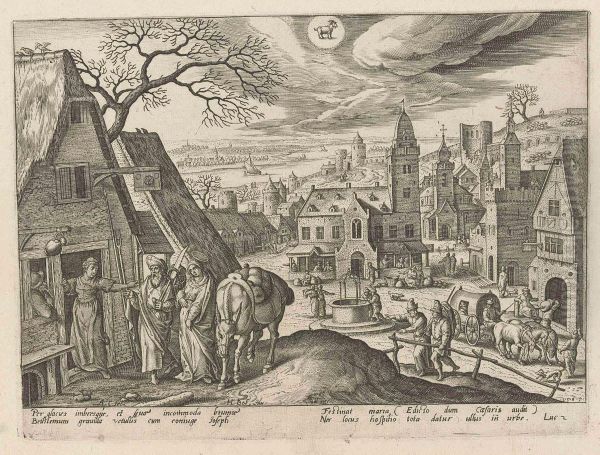
Hans Bol was among them. He did not wait for the fall of Antwerp. Sources indicate he left Antwerp around 1584. He is recorded as living briefly in several cities in the north, including Bergen op Zoom, Dordrecht, and Delft, before finally settling in Amsterdam. Amsterdam was rapidly emerging as a major commercial and cultural center, attracting talent from across Europe. Bol became a citizen (burgher) of Amsterdam in 1591.
In Amsterdam, Bol continued his successful career, producing miniatures, drawings for prints, and larger paintings. His style remained popular, and he found ready patrons in the burgeoning Dutch art market. His later works continued to display his characteristic attention to detail and his love for landscape, though perhaps with an increasing tendency towards the more intimate and naturalistic landscapes that would come to define the Dutch Golden Age.
The exact date of Hans Bol's death has been subject to some scholarly debate. While many sources cite his death in Amsterdam on November 20, 1593, and his burial in the Oude Kerk, some documents, including a 1595 record, suggest he might have been alive later. However, the 1593 date is the most commonly accepted.
Legacy and Enduring Influence
Hans Bol's influence on the art of the Low Countries was significant, particularly in the development of landscape and miniature painting. His meticulous technique, his ability to capture atmospheric effects, and his charming depictions of daily life and nature resonated with both contemporary audiences and later generations of artists.
Through his students, notably Joris Hoefnagel and Jacob Savery I, his artistic principles were transmitted and further developed. Hoefnagel, in particular, carried the tradition of highly detailed miniature painting and naturalistic illustration to the imperial court in Prague, influencing the art of Central Europe. Jacob Savery I became part of the lineage of Dutch landscape and animal painters.
Bol's numerous drawings, widely disseminated through prints, provided models and inspiration for many other artists. His landscape compositions, with their careful structuring of space and attention to natural detail, helped lay the groundwork for the great flourishing of Dutch landscape painting in the 17th century. Artists like Esaias van de Velde (c. 1587–1630) and Jan van Goyen (1596–1656), while developing their own distinct styles, built upon the traditions established by Bol and his contemporaries.
The popularity of Bol's work during his lifetime is attested to by the numerous copies and imitations, a testament to the market demand for his art. While this created problems for the artist himself, it also speaks to the widespread appeal of his style. His ability to adapt, shifting from large-scale watercolors to highly prized miniatures, demonstrates his artistic versatility and business acumen.
Hans Bol's Works in Collections Worldwide
Today, Hans Bol's works are held in the collections of major museums and galleries across the globe, allowing art lovers and scholars to appreciate his contributions to Renaissance art.
In the United States, his works can be found in the Harvard Art Museums (Cambridge, Massachusetts), which hold pieces like An Allegory of Autumn and Abraham and the Angels. The Metropolitan Museum of Art in New York possesses works such as Winter Landscape with Skaters. The Cleveland Museum of Art has his Balaam and the Ass. Other American institutions with Bol's art include the Art Institute of Chicago, the Fine Arts Museums of San Francisco, the J. Paul Getty Museum in Los Angeles, the Princeton University Art Museum, and the Philadelphia Museum of Art.
In Europe, the Mayer van den Bergh Museum in Antwerp is home to his celebrated Landscape with the Fall of Icarus. The Rijksmuseum in Amsterdam (and its former St. Petersburg branch) holds significant works. The Museum Boijmans Van Beuningen in Rotterdam is said to house his first known painting. In Vienna, the Kunsthistorisches Museum and the Albertina have examples of his art. The Louvre Museum in Paris also includes his works in its collection. The National Gallery in London, the Royal Museums of Fine Arts of Belgium in Brussels, and the National Gallery of Denmark (Statens Museum for Kunst) in Copenhagen are other prominent European institutions featuring Bol's art. His drawings and prints are also found in the print rooms of many of these museums.
Auction houses like Sotheby's and Christie's regularly feature works by Hans Bol or his circle, indicating a continued interest among private collectors. For instance, works have appeared in sales in London and New York, and some pieces reside in distinguished private collections, such as the former Kuklanský Collection in the National Gallery Prague.
Conclusion: An Enduring Vision
Hans Bol was an artist of remarkable skill and adaptability. Navigating a period of profound social and political change, he carved out a successful international career, excelling in various media, from large-scale watercolors to intricate miniatures and influential print designs. His keen observation of nature, his mastery of detail, and his ability to imbue landscapes with narrative and atmospheric depth place him among the key figures of late 16th-century Northern European art.
His legacy is twofold: a body of beautiful and meticulously crafted artworks that continue to delight viewers, and a significant influence on the subsequent development of landscape painting and miniature art in the Low Countries and beyond. Hans Bol's vision of the world, whether in grand panoramic vistas or tiny, jewel-like scenes, remains a testament to the enduring power of art to capture both the specifics of a time and place and the universal appeal of nature and human experience.